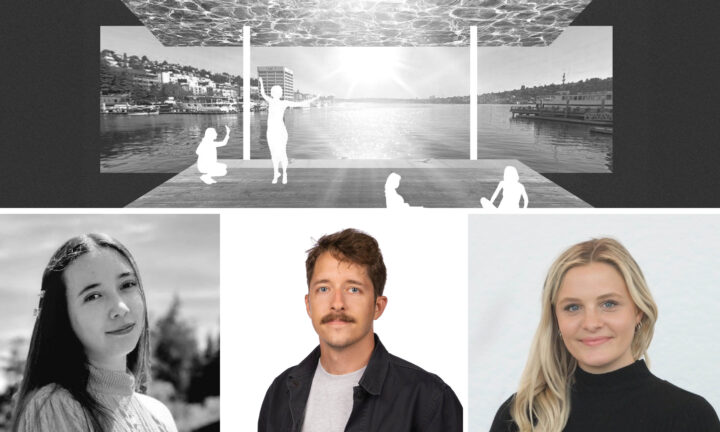Olson Kundig is back at the Festival this year with their latest and greatest installation – Underwater. The built installation celebrates the significance of water in the Pacific Northwest community through an immersive and sensory experience. Underwater invites people to interact with water, light, and surfaces, engaging each of their five senses and fostering a deeper connection with themselves and the environment.
The Olson Kundig team is ready to make a splash at the Block Party! Hear about what inspires their work in design.
Adriana Marquez (she/her, above left) | Intern (former)
Brian Havner (he/him, above middle) | Architect
Gabrielle Clune (she/her, above right) | Designer
Jaclyn Jung (she/her, not pictured) | Project Manager
Q&A
CURIOSITY in design is…
Gabrielle: CURIOSITY in design is the driving force that fuels innovation and creativity. It’s the willingness to ask questions and seek out unconventional solutions. Curiosity allows us to push the boundaries of design.
How does design influence CURIOSITY?
Jaclyn: Design is all about curiosity! Curiosity is a natural driver to be inventive and leads to creative thinking, which helps propel design. Design and curiosity work symbiotically to push forward better ideas, and curiosity is a natural requirement to solving problems – a key tenet of design.
Gabrielle: Design driven by curiosity has a profound impact on the way people experience and interact with space. It encourages engagement and ignites a sense of wonder. By incorporating elements that pique curiosity, we can create spaces that leave a lasting impression, encouraging people to explore, learn, and discover.
How do you use CURIOSITY in your work?
Gabrielle: At Olson Kundig, we embrace curiosity in our work by constantly challenging ourselves to think differently and integrate diverse perspectives. We encourage our teams to explore new materials, technologies, and design approaches. By fostering an environment of curiosity, we create projects that surprise, delight, and inspire.
Brian: Curiosity is often the source of my work. While traditional means and methods of creation are valuable to learn from, I try to misread or reinterpret those approaches to discover something novel and unexpected. For instance, this might arise from a different application of a material than is typically used, or from implementing new technology to an old idea. Who knows!
Who or what inspires you?
Adriana: I am inspired by the rich diversity of the cultural and natural world we live in. We have great potential to transform and improve it, one small part at a time.
Gabrielle: At Olson Kundig, we thrive on uncovering the hidden quirks and beauty within overlooked environments, using curiosity to discover unique elements that inspire our designs and create meaningful connections with people and their surroundings.
My favorite thing about my city is…
Jaclyn: The incredible access to the outdoors and the mountains, against the urban backdrop of the city and industry that drives it. We are really lucky to experience such a vibrant and rich landscape in Seattle, for both our urban and natural resources.
Tell us about a project that you completed that you are most proud of.
Brian: I thoroughly enjoy working on projects that involve the Seattle community. Last year, I had the privilege of representing Olson Kundig in the Museum of Museum’s Cat Tower exhibition, which turned out to be a tremendous success. Our cat tower was designed as a stack of pillows, providing the perfect environment for cats to explore and enjoy the various nooks and crevices. All of the cats that visited told me they loved it!
If you could have one superpower, what would it be and why?
Jaclyn: Flying would be amazing. Seeing the world from above is a completely unique perspective and one that people have been obsessed with for decades (flying planes, going up into space…).
Adriana: I would like to be able to teleport myself. I feel that it would make life easier, to get places faster and be able to enjoy life more without worrying about the time it takes to get there.
How should community influence design?
Jaclyn: Community is very often the end user of design, and a key aspect of good design is having great input from and consideration of the user. Design has the ability to positively influence a community through successful programming and public spaces, but in order to become a success, the design must account for, and be influenced by, community.
Gabrielle: Community should be at the heart of every design process. Understanding the needs, desires, and aspirations of the community is essential to create spaces that truly serve and empower them.





